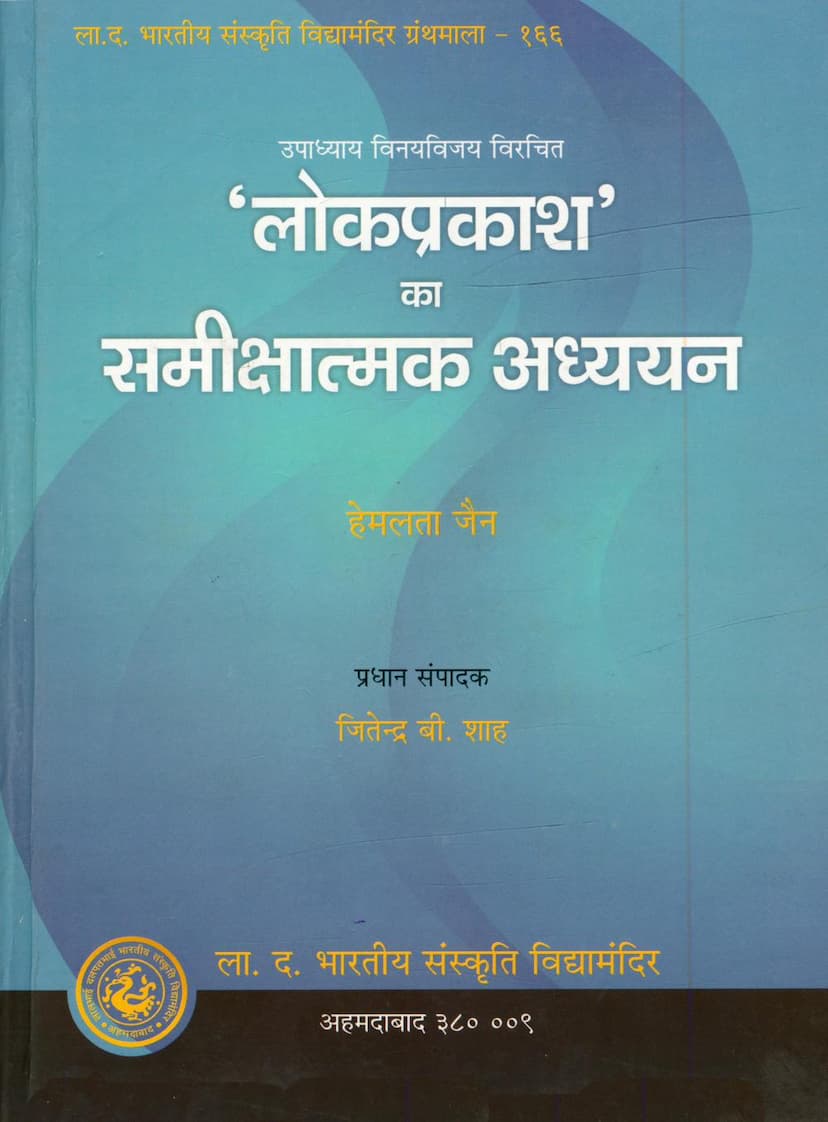Lokprakash Ka Samikshatmak Adhyayan
Added to library: September 2, 2025

Summary
This is a comprehensive summary of the book "Lokprakash Ka Samikshatmak Adhyayan" by Hemlata Jain, published by L. D. Institute of Indology. The book is a critical study of "Lokprakash," a significant work by Upadhyaya Vinayavijaya.
Book Overview:
"Lokprakash," authored by the esteemed Jain scholar Upadhyaya Vinayavijaya (1661-1738), is a profound Sanskrit text comprising 37 chapters and approximately 18,000 verses. It systematically presents Jain philosophical concepts across four domains: Dravyalaok (Substance Realm), Kshetraalok (Space Realm), Kalaalok (Time Realm), and Bhavalok (State/Condition Realm), encompassing almost all entities within Jain Dharma. Dr. Hemlata Jain's critical study delves into this monumental work, providing a comparative analysis that utilizes texts from both the Shvetambara and Digambara traditions, making it an invaluable resource for scholars and students of "Lokprakash."
Author and Her Work:
Dr. Hemlata Jain conducted this research for her Ph.D. at Jai Narayan Vyas University, Jodhpur, in 2006. The published book is the result of this meticulous study.
Upadhyaya Vinayavijaya: Personality and Literary Contributions:
The book dedicates its first chapter to Upadhyaya Vinayavijaya's life and works. He was a prominent figure in the 17th century, renowned for his intellect, poetic talent, grammatical expertise, philosophical depth, and mastery of Jain Agamas and other literary works. He was a contemporary of the great Jain philosopher Upadhyaya Yashovijaya. The text highlights their close intellectual relationship and mutual respect, noting that Yashovijaya completed Vinayavijaya's unfinished work, "Shripal Rajano Ras." Vinayavijaya's prolific literary output is categorized into nine departments:
- Agama commentary and Sajjhay literature
- Historical literature
- Spiritual compositions
- Stotras and Stavan (hymns and praises)
- Grammatical works
- Ras and Phagu poetry
- Pooja methodology literature
- Doot Kavya, Geeti Kavya, and Vigilapti Lekh (message poetry, lyrical poetry, and formal letters)
- Philosophical literature
His magnum opus, "Lokprakash," is presented as a culmination of his expertise as an Agama scholar, philosopher, and poet.
Structure and Content of "Lokprakash" as Analyzed by Dr. Hemlata Jain:
Dr. Jain's study meticulously analyzes "Lokprakash" chapter by chapter, detailing the core philosophical tenets presented:
-
Chapter 1: Upadhyaya Vinayavijaya: Personality and Literary Contributions: This chapter focuses on the life, lineage, contemporaries, and diverse literary output of Upadhyaya Vinayavijaya, establishing his scholarly and spiritual stature.
-
Chapter 2: The Nature of Lok and Enumeration of Souls (1): This chapter discusses the concept of "Lok" in Jainism, categorizing it into Dravyalaok, Kshetraalok, Kalaalok, and Bhavalok. It delves into the six substances (Sadravya) and provides a detailed analysis of souls, their classifications, enumeration, vital principles (Prana), stages of development (Paryapti), birth places (Yoni), life spans (Bhavasthiti), body types (Sharir), bodily configurations (Sansthan), and expulsion from the body (Samudghata). It covers the classification of souls from one-sensed (Ekendriya) to five-sensed (Panchendriya) beings, emphasizing the Jain perspective on consciousness in even the most elemental life forms.
-
Chapter 3: Enumeration of Souls (2): This chapter continues the discussion on souls, focusing on concepts like avagahana (spatial occupation), samudghata (expulsion of soul-matter), gati-aagti (movement and origin), leshya (soul-color/mental state), digahara (direction of food intake), samhanana (bone structure), and kashaya (passions). It examines the intricacies of these states and their impact on the soul's journey.
-
Chapter 4: Enumeration of Souls (3): This chapter delves into further aspects of the soul, including samjna (mental disposition), sensory organs (Indriya), desires (Veda), perception (Drishti), knowledge (Gyan), perception (Darshan), application (Upayog), sustenance (Aahar), stages of spiritual development (Gunasthan), and activities (Yoga). It explores the complex interplay of these factors in the soul's existence.
-
Chapter 5: Enumeration of Souls (4): This chapter concludes the soul-centric discussions by examining yoga (activities), pride (Man), relative quantities (Alpabahutva), time intervals (Antar), bond of births (Bhavsanvedh), and the ultimate quantitative analysis (Maha-Alpabahutva).
-
Chapter 6: Kshetraalok (Space Realm): This chapter provides a comprehensive overview of the Jain cosmological map, detailing the 14 rajus of the universe, the structure of the 'Trasanali' (region inhabited by mobile beings), and the proportional measurement of the universe. It explains the nomenclature of the upper, middle, and lower worlds, the vital air envelope (Vatvalay), and the characteristics of the direction and sub-directions. The detailed description of the lower world (Adholok), middle world (Madhyalok), and upper world (Urdhvalok) includes specific regions like Jambudvipa, Meru Parvat, Dhataki Khand, and Ardha Pushkara Dvipa.
-
Chapter 7: Kalaalok (Time Realm): This chapter critically examines Upadhyaya Vinayavijaya's arguments regarding the independent existence of Time as a substance. It presents both sides of the debate and ultimately supports Vinayavijaya's reasoning for establishing time as a distinct entity. The chapter also discusses the nature of time, its functions, and its various classifications, including measurement units like P Palyopama, Sagroapama, and Pudgala Paravartana.
-
Chapter 8: Bhavalok (State/Condition Realm): This chapter explores the eight types of karmas and the 14 gunasthanas (stages of spiritual development) in relation to the six states of being (Bhavas): Aupashamik (suppressed), Kshyayik (eradicated), Kshayopashamik (partially suppressed/eradicated), Audayik (due to fruition), Parinamik (inherent), and Sannipatik (combination of states). Dr. Jain systematically analyzes their interrelationships as presented by Vinayavijaya.
Key Features of Dr. Jain's Study:
- Comparative Analysis: Dr. Jain's work is distinguished by its comparative approach, drawing upon texts from both Shvetambara and Digambara traditions to offer a balanced and thorough analysis.
- Systematic Approach: The book systematically breaks down the vast content of "Lokprakash" into manageable chapters, each addressing specific philosophical concepts.
- Lucid Explanation: It clarifies complex Jain philosophical terms and concepts, making them accessible to a wider audience.
- Contribution to Jainology: The critical study serves as a significant contribution to the field of Jainology, illuminating the depth and breadth of Upadhyaya Vinayavijaya's "Lokprakash."
- Valuable Resource: It is highly beneficial for students and researchers interested in the philosophical and cosmological aspects of Jainism, particularly those focusing on Upadhyaya Vinayavijaya's seminal work.
In essence, Dr. Hemlata Jain's "Lokprakash Ka Samikshatmak Adhyayan" offers a scholarly and detailed examination of Upadhyaya Vinayavijaya's "Lokprakash," providing a deep dive into the fundamental principles of Jain Dharma and philosophy.